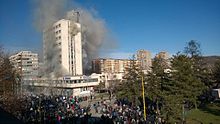Anarchism in Bosnia and Herzegovina
| Part of a series on |
| Anarchism |
|---|
 |
Anarchism in Bosnia and Herzegovina first emerged from left-wing currents of the anti-imperialist movement, gaining traction as a tendency in the revolutionary organization
History
Anti-imperialist movement
Anarchism first emerged in the country from

The subsequent
Žerajić's example was followed by several more attempted assassinations of Austro-Hungarian officials, the most significant of which was the
Yugoslavia
Following the end of
Post-independence

The death of Tito and the subsequent
This new status quo once again gave rise to anarchism within the country, after having been suppressed for nearly a century of authoritarian rule by various different parties. The rise of the Dosta movement from internet forums to public meetings brought about a form of libertarian organizing that transcended ethnic divisions. As it grew, it began to confront social and economic issues, even beginning to take
On 19 May 2020, Bosnian anarchist and anti-fascist activist
See also
References
- ^ a b c d e Indic, Trivo (27 May 1990). "The anarchist tradition on Yugoslav soil". Umanità Nova. Retrieved 17 October 2014.
- ^ Belgrade (Serbia). Vojni muzej Jugoslovenske narodne armije (1968). Fourteen centuries of struggle for freedom. The Military Museum. p. li.
- ISBN 9788683651627.
- ISBN 978-86-7363-604-7.
- ISBN 9788671910156.
- OCLC 400010.
- ISBN 9781847654168.
- ISBN 0-89712-122-8.
- ^ Pappenheim, Martin (1916). "Conversations With Gavrilo Princip".
- ^ "Alexander I | king of Yugoslavia". Encyclopedia Britannica. Retrieved 7 June 2019.
- ISBN 0299148742.
- ISBN 978-1-55753-455-2.
- ISBN 978-0199327850.
- ^ Simic, Aleksandar (November 1995). "The workers' movement in Serbia and ex-Yugoslavia". Translated by Will Firth. Revolutionary Group TORPEDO. Archived from the original on 30 June 2012.
- ^ a b c "Anarchists in the Bosnian Uprising". CrimethInc. 18 February 2014. Retrieved 26 January 2021.
- ^ Katalenac, Juraj (6 February 2014). "What's up with Bosnia?". Insurgent Notes. Retrieved 26 January 2021.
- ^ Gavroche, Julius (31 March 2014). "All power to the plenums: Bosnia and Herzegovina's insurrection". Autonomies. Retrieved 26 January 2021.
- ^ "Man detained after threatening Bosnia's Archbishop". N1 Sarajevo. 22 January 2021. Retrieved 22 May 2023.
- ^ Hartmann, Graham (22 May 2020). "Axe-Wielding Metalhead YouTuber Arrested for Video Against the Catholic Church". Loudwire. Townsquare Media, Inc. Retrieved 22 May 2023.
- ^ Thalen, Mikael (23 May 2020). "Metalhead YouTuber arrested after criticizing the mourning of executed pro-Nazi militants". Daily Dot. Retrieved 22 May 2023.
